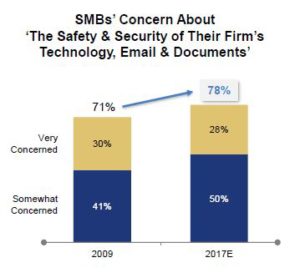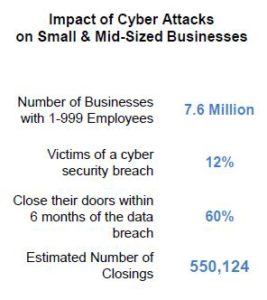
For any business, but especially a smaller one without deep pockets, the consequences of some disaster may mean the end of the business. As a result, risk evaluation becomes critical. There are an endless variety of events, from mishaps to major disasters that challenge your viability. Risk management inventories all of the possible risks that could befall the organization and places them in a hierarchy of significance. At the top are single points of failure disasters or extreme events that would shut down the business, at least temporarily. Risk management then works to channel limited resources toward mitigating the most serious risks. Here are some examples of risk in the IT area that could be especially damaging if left unprotected
Data Security and Cybercrime –
- Loss of data – Failed backups or human error can lead to lost data. Every business needs to have the IT expertise to ensure that quality backups are maintained, preferably in real-time
- Data breaches – More significantly, data is constantly at risk from crime. From malware to ransomware, viruses and cyber attacks can destroy a small business. Consequently, quality IT support is most critical in this area. It should be an issue of highest priority.
Hardware redundancy – Your entire physical IT infrastructure represents a vulnerability. Single points of failure could shut down your business. Proper design of your infrastructure, and 24/7 monitoring of it is, again, a risk mitigation factor. How much evaluation has been done to determine your level of risk?Natural and human-made disasters – How prepared is your IT infrastructure to continue operations in the event of a flood, fire, or natural disaster that prohibits access to your physical location? How would you handle a long-term power of broadband outage? IT professionals skilled in disaster recovery can help you mitigate the risk in the face of a major event.
The point here is not to list all the possible risks you face, but to recognize that IT support should be focused on the most critical areas. Whether you bring them in-house or use the services of an MSP, resources should be directed first at areas where the risk is greatest.
How can an MSP help support a risk-focused IT strategy?
- Hiring individual in-house support can be expensive and slow – Given the tight labor market, finding ideal candidates can be exceptionally difficult, and as a consequence, too expensive. An MSP represents a faster way to bring on support and can be utilized only when and where the most critical services are needed.
- Up-to-date support – Over-worked in-house IT staff in a small company may be too busy putting out fires to keep up with the latest developments in specific corners of their field. As a result, you may lack the knowledge depth needed on narrow but critical areas. IT is a very broad field, and only a diverse IT team has the depth to cover all of the different areas. With an MSP, you don’t have to worry about how technology is changing. A good MSP will not only be up-to-date with the latest in tech but also advise you on what tech changes you need to make to stay ahead.
- Scalability – The size of your in-house IT support staff is, in the short term, static. If you experience peak demand times, resources can be stretched to the point of being overwhelmed. .Choosing a managed services provider, however, provides the flexibility to scale up or scale down your IT investment to suit your business needs.
- 24/7 monitoring and availability – Until your organization gets big enough, an in-house IT staff cannot be available 24/7. Nor can it provide 24/7 monitoring for that part of your business that must be functional all the time. An MSp has the resources, because of economies of scale.
In the end, don’t think of IT support as “IT Hiring” instead, think of it as staffing. What is the best use of limited resources to meet your most immediate vulnerabilities? That is the best perspective to take on IT support when resources are limited.

 +(214) 550-0550
+(214) 550-0550
 “Initiatives like World Backup Day serve as a timely reminder to businesses not only of the need to back up data, but also to protect and carefully manage this invaluable asset. Like all risk based strategies, businesses must know what really needs to be backed up in the first place. In other words, businesses must understand what the ‘mission critical data’ actually is.
“Initiatives like World Backup Day serve as a timely reminder to businesses not only of the need to back up data, but also to protect and carefully manage this invaluable asset. Like all risk based strategies, businesses must know what really needs to be backed up in the first place. In other words, businesses must understand what the ‘mission critical data’ actually is. Brian Ussher, President and Co-Founder, iland said: “On World Backup Day, it’s a good time to recognise how far the market has come in protecting mission-critical business data. The scalability, flexibility and on-demand nature of the cloud means that backup and DR strategies that were previously only available to large enterprise customers are now also within the reach of small and medium sized businesses.
Brian Ussher, President and Co-Founder, iland said: “On World Backup Day, it’s a good time to recognise how far the market has come in protecting mission-critical business data. The scalability, flexibility and on-demand nature of the cloud means that backup and DR strategies that were previously only available to large enterprise customers are now also within the reach of small and medium sized businesses. Jon Leppard, Director, Future Facilities said: “A comprehensive backup policy should involve keeping copies of data on a local server or hard drive, but most importantly it should also be stored in an external location –usually a datacentre. But even datacentres have capacity limits on the volume of data they can store at any one time. If everyone were to back up at the same time there would be considerable pressure on network bandwidth and global data centre capacity.
Jon Leppard, Director, Future Facilities said: “A comprehensive backup policy should involve keeping copies of data on a local server or hard drive, but most importantly it should also be stored in an external location –usually a datacentre. But even datacentres have capacity limits on the volume of data they can store at any one time. If everyone were to back up at the same time there would be considerable pressure on network bandwidth and global data centre capacity. Richard Agnew, VP NW EMEA, Veeam said: “In today’s connected world, businesses need to ensure availability to avoid a breakdown in operations.
Richard Agnew, VP NW EMEA, Veeam said: “In today’s connected world, businesses need to ensure availability to avoid a breakdown in operations. “The amount of data captured by businesses every day can be a huge asset, unlocking valuable insights and creating competitive advantage. However, this same information can also cause serious headaches for those tasked with securely storing and managing it – and GDPR is putting a time limit on the need to get this right.
“The amount of data captured by businesses every day can be a huge asset, unlocking valuable insights and creating competitive advantage. However, this same information can also cause serious headaches for those tasked with securely storing and managing it – and GDPR is putting a time limit on the need to get this right.
